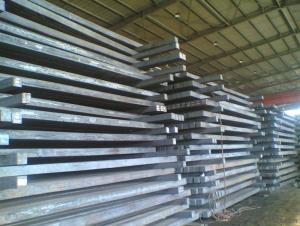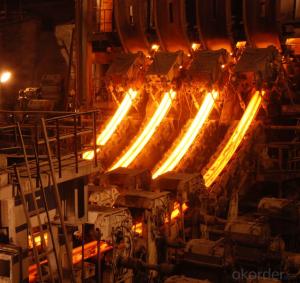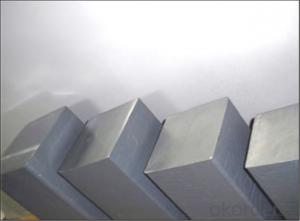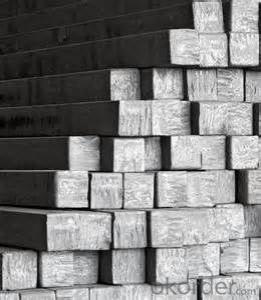Square Steel Billet Q235 3SP Grade Prime Quality 7#
- Loading Port:
- Tianjin
- Payment Terms:
- TT OR LC
- Min Order Qty:
- 2000 m.t
- Supply Capability:
- 50000 m.t/month
OKorder Service Pledge
OKorder Financial Service
You Might Also Like
Description of Square Steel Billet Q235 3SP Grade Prime Quality 7#
M. S. Billets are used for rolling of TMT Re-Bars of Fe415 and Fe500 Grade and various other structural steel products.
CRS Billets are used for rolling of CRS TMT Re-Bars.
Special Alloy Billets are used for rolling of any special grade TMT Re-Bars like Earthquake resistant TMT Re-Bars and for special grade structural steel products.
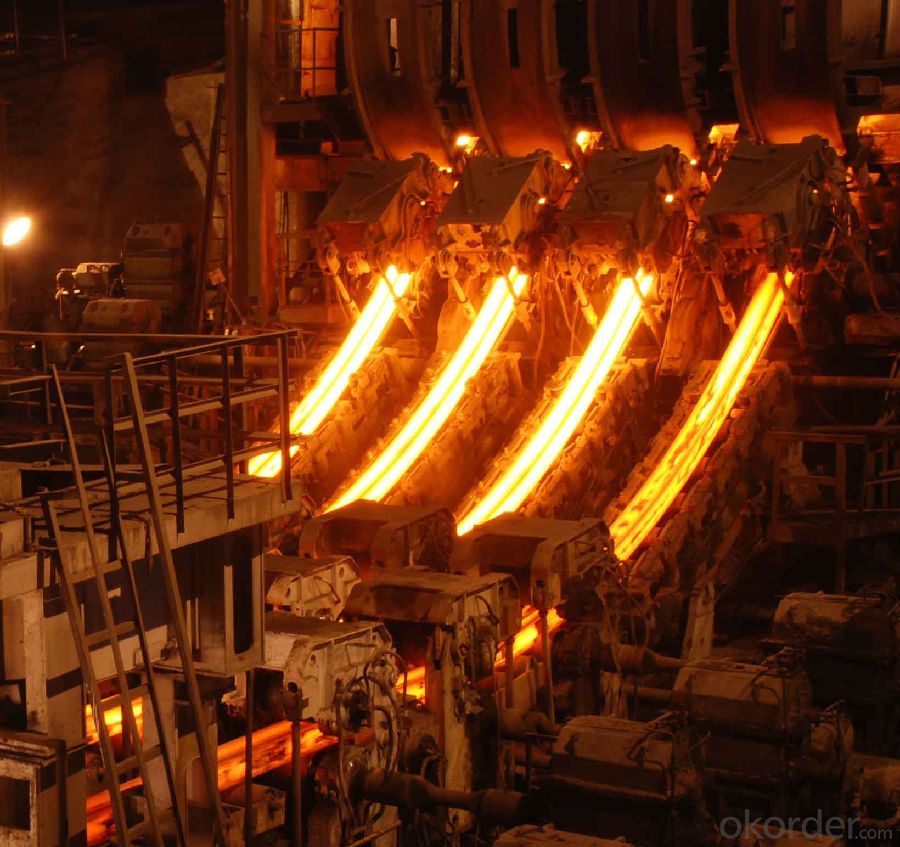
Main Feature Square Steel Billet Q235 3SP Grade Prime Quality 7#
Raw elements(C,Fe,Ni,Mn,Cr,Cu.)---Smelted ingots by AOD finery---hot rolled into black suface---pickling in acid liquid---cold drawn----polished by automatically machine--- cutting into pieces---checking quanlity
Applications of Square Steel Billet Q235 3SP Grade Prime Quality 7#
Widely Used in the areas such as Stainless Steel Fasteners, Chains, Kitchen and Sanitary wares, Furniture handles, Handrails, Electroplating and Electrolyzing pendants, Foods, Electron, Petroleum, Construction and Decoration, etc. Products have a high strength after cold-working. Electronic products parts, Medical appliance, Springs, Bus Inside and Outside packaging and building, Street Lamp Posts, etc. Decoration materials and Outdoor Publicity Billboard. Used for the products which have the Anti-Stress Corrosion requirement. Electron Products, Table-wares, Bolts, Nuts, Screen Meshes, Cumbustors and so on.
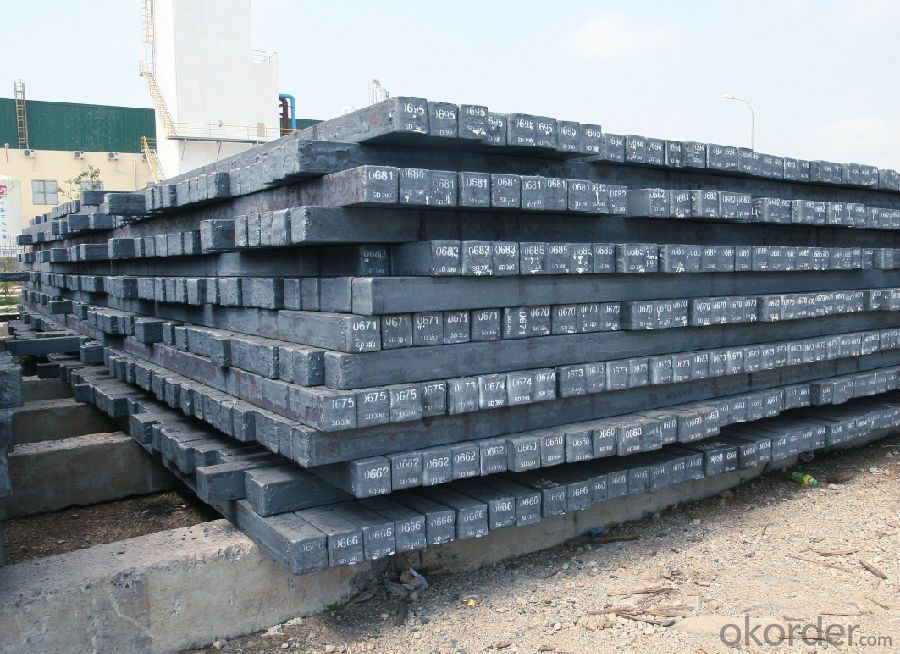
Specifications of Square Steel Billet Q235 3SP Grade Prime Quality 7#
| Standard | C(%) | Mn(%) | S(%) | P(%) | Si(%) |
| Q195 | ≤0.12 | ≤0.50 | ≤0.040 | ≤0.035 | ≤0.30 |
| Q235 | ≤0.20 | ≤1.40 | ≤0.045 | ≤0.045 | ≤0.35 |
| Q275 | ≤0.22 | ≤1.50 | ≤0.045 | ≤0.045 | ≤0.35 |
| 20MnSi | 0.17-0.25 | 1.2-1.6 | ≤ 0.050 | ≤ 0.050 | 0.40-0.80 |
| 3SP | 0.14-0.22 | 0.40-0.85 | ≤ 0.050 | ≤ 0.040 | 0.05-0.15 |
| 5SP | 0.28-0.37 | 0.50-1.00 | ≤ 0.050 | ≤ 0.040 | 0.15-0.30 |
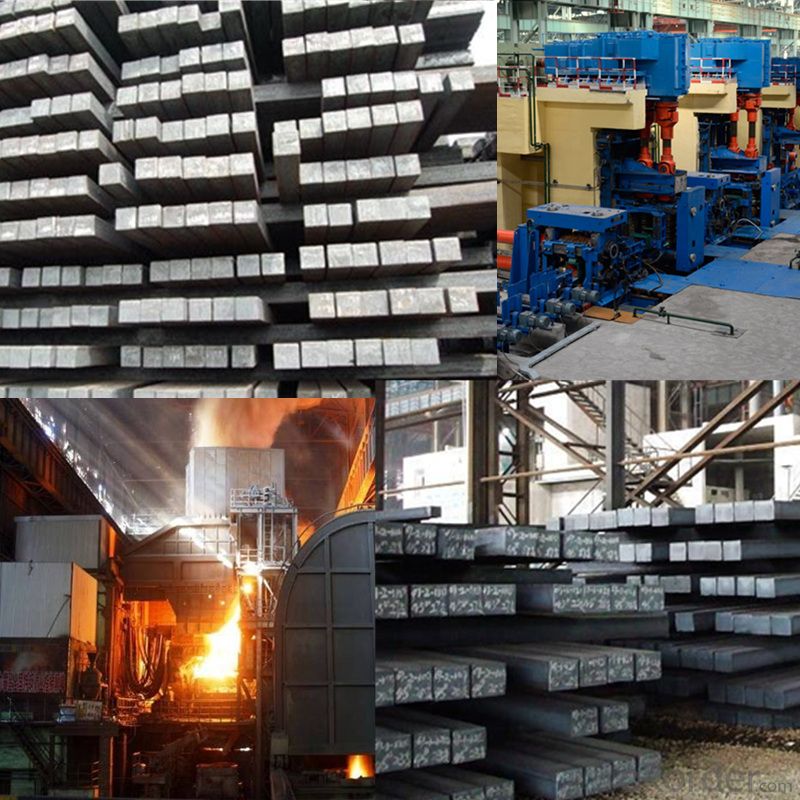
FAQ of Square Steel Billet Q235 3SP Grade Prime Quality 7#
We have organized several common questions for our clients,may help you sincerely:
1. How Can I Visit There?
Our company is located in Tianjin City, China, near Beijing. You can fly to Tianjin Airport Directly. All our clients, from home or aboard, are warmly welcome to visit us!
2. How Can I Get Some Sample?
We are honored to offer you sample.
3. Why choose CNBM?
Our delivery time about 15-20days for standard sizes, if you have other requirements like hardness, quanity and width ,it is about 20-40days. But don't worry we also try our best for the delivery time ,because time longer and our cost is higher.
- Q:Can steel billets be used in the production of utensils and cutlery?
- Utensils and cutlery can indeed be produced using steel billets. These semi-finished products have the potential to be transformed into a variety of shapes and forms, including utensils and cutlery. The remarkable properties of steel, such as its strength, durability, and resistance to corrosion, make it an ideal choice for manufacturing these items. In the production process, steel billets are often melted and cast into specific shapes. They are then further processed through techniques like forging, stamping, or machining to create the desired utensils and cutlery items. The range of final products is extensive, encompassing not only spoons, forks, and knives but also more intricate items like serving spoons, ladles, and cheese slicers. Steel utensils and cutlery are highly regarded and widely used due to their long-lasting nature and hygienic qualities.
- Q:What are the different methods of surface cleaning for steel billets?
- Some of the different methods of surface cleaning for steel billets include abrasive blasting, acid pickling, mechanical cleaning, and electrochemical cleaning.
- Q:What is Alfa carbon? What is beta carbon?
- Alfa is directly connected with the functional groups of carbon atoms of carbon atoms, such as CH3CH2COOH CH2 in which methylene propionate is Alfa carbon carbon carbon atom is the beta carbon atom is directly connected with the functional groups and the connection of the carbon (around Kazakhstan), such as the CH3CH2COOH CH3 propionic acid methyl carbon is the beta carbon
- Q:What are the main factors affecting the metallurgical properties of steel billets?
- There are several main factors that affect the metallurgical properties of steel billets. These factors include the composition of the steel, the heat treatment applied, the presence of impurities, and the cooling rate. The composition of the steel plays a crucial role in determining its metallurgical properties. The amount of carbon, as well as the presence of other alloying elements such as manganese, chromium, and nickel, can significantly impact the steel's strength, hardness, and ductility. Different compositions can also affect the steel's ability to resist corrosion or exhibit magnetic properties. Heat treatment is another important factor that affects the metallurgical properties of steel billets. This process involves heating the steel to a specific temperature and then cooling it at a controlled rate. Heat treatment can alter the microstructure of the steel, which in turn affects its hardness, toughness, and overall mechanical properties. Different heat treatment methods, such as annealing, quenching, and tempering, can be applied to achieve desired metallurgical properties. Impurities present in the steel can also influence its metallurgical properties. Common impurities include sulfur, phosphorus, and oxygen. These impurities can negatively impact the steel's mechanical properties, such as reducing its strength and ductility. Therefore, the level of impurities needs to be minimized to ensure the desired metallurgical properties. Lastly, the cooling rate during the solidification process plays a crucial role in determining the microstructure and properties of the steel billets. Rapid cooling, such as in the case of quenching, can result in a fine-grained microstructure, which enhances the steel's strength and hardness. On the other hand, slow cooling, such as during annealing, can lead to a coarse-grained microstructure, which improves the steel's ductility and toughness. In conclusion, the main factors affecting the metallurgical properties of steel billets include the composition of the steel, the heat treatment applied, the presence of impurities, and the cooling rate. These factors are interrelated and need to be carefully controlled to achieve the desired properties for different applications.
- Q:What are the different surface defects that can be found in steel billets?
- Some common surface defects that can be found in steel billets include cracks, scale, pits, inclusions, and surface roughness.
- Q:How are steel billets used in the production of wind turbine towers?
- Steel billets play a crucial role in the production of wind turbine towers. These billets, which are essentially semi-finished steel products, are used as the raw material in the manufacturing process of wind turbine towers. Firstly, steel billets are carefully selected based on their specific properties such as strength, durability, and corrosion resistance. These properties are vital as wind turbine towers need to withstand strong winds, harsh weather conditions, and long-term exposure to environmental elements. Once the appropriate steel billets are chosen, they undergo a series of manufacturing processes. These processes often include heating, rolling, and shaping the billets into the desired form for wind turbine towers. Heating the steel billets to high temperatures makes them malleable and easier to shape. After the heating process, the steel billets are rolled into long cylindrical shapes, resembling the final structure of the wind turbine tower. These rolled billets are then forged and welded together to form seamless tower sections. The welding process ensures the structural integrity and stability of the tower. Furthermore, steel billets are also used in the construction of the tower's foundation. Large steel billets are embedded deep into the ground to provide a stable base for the tower. This helps to anchor the tower securely, preventing any potential movements or instability. Overall, steel billets are fundamental in the production of wind turbine towers as they provide the necessary strength and durability required for these structures. Without steel billets, it would be nearly impossible to construct wind turbine towers that can withstand the demanding conditions they are exposed to.
- Q:Reasons and treatment methods of billet stripping in continuous casting
- even two cold regions can be uniformly cooled, due to uneven thickness of shell, caused by the inconsistent temperature, the shell shrinkage is still uneven, and also there will be the development of. Therefore, the selection of unqualified mold is the main reason causing the removal. Secondly, the cooling effect of the two cooling zone can not be ignored.
- Q:What is the size and shape of steel billets?
- The intended use of steel billets determines their sizes and shapes, which can vary. Typically, they have a rectangular form and their dimensions can range from small to large. The length can vary from several inches to several feet, while the width and height can adjust accordingly. These measurements are determined by the specific needs of the steel manufacturing process and the desired final product. Furthermore, steel billets can be customized to meet specific production requirements, such as square or round shapes.
- Q:How are steel billets used in the manufacturing of industrial compressors?
- Steel billets are an integral part of the manufacturing process for industrial compressors. These billets, which are essentially semi-finished steel products in the form of a rectangular solid, serve as the starting material for creating various components of the compressor. Firstly, steel billets are heated to high temperatures and then passed through a series of rolling mills to be shaped into specific forms such as bars, rods, or sheets. These processed steel billets are then used to fabricate critical components of the compressor, including the crankshaft, connecting rods, cylinder blocks, and piston rings. The crankshaft, a central component responsible for converting the reciprocating motion of the piston into rotational motion, is typically forged from a steel billet. The billet is subjected to controlled heating, shaping, and machining processes to achieve the desired shape and strength required for the crankshaft to withstand the high pressures and forces within the compressor. Similarly, connecting rods, which connect the piston to the crankshaft, are also manufactured from steel billets. These billets are machined to precise dimensions and undergo various heat treatment processes to ensure optimal strength and durability. Cylinder blocks, the main structural frame of the compressor, are often casted from steel billets. The billets are melted and poured into molds to form the desired shape. Once solidified, the cylinder block undergoes further machining to create the cylinder bores, mounting surfaces, and other necessary features. Additionally, steel billets are used to produce piston rings, which are crucial for maintaining proper compression and preventing leakage. The billets are machined and then subjected to heat treatment processes to enhance wear resistance and ensure a proper fit within the cylinder. Overall, steel billets are essential in the manufacturing of industrial compressors as they provide the raw material for creating key components. The ability to shape and process steel billets allows for the production of strong, durable, and high-performance compressors that can meet the demanding requirements of various industries.
- Q:How are steel billets used in the manufacturing of fasteners and fittings?
- Steel billets are an essential raw material in the manufacturing of fasteners and fittings. Fasteners, such as bolts, screws, and nuts, are used to hold two or more components together securely. Fittings, on the other hand, are used to connect or join different parts of a structure or system. To manufacture fasteners and fittings, steel billets undergo several processes. Initially, the billets are heated to a high temperature to make them malleable. This heating process, known as hot rolling, allows the steel billets to be shaped into the desired form. The billets are then passed through a series of rollers, which gradually reduce their thickness and increase their length. This process transforms the billets into long, slender rods known as wire rods. The wire rods are subsequently cold drawn or cold rolled to further refine their shape and dimensions. This process improves the surface finish and increases the strength of the rods. The cold drawing or rolling process results in the formation of wires with precise diameters, which are then used to manufacture fasteners such as screws, bolts, and nuts. The wires are cut into specific lengths and threaded to create the necessary grooves and patterns required for fastening. The threads on the wires allow them to be easily screwed into or onto other components, providing a secure and reliable connection. The shape and size of the threads are crucial as they determine the compatibility of the fasteners with different applications. For fittings, the wire rods are subjected to additional processes such as machining, bending, or welding. Machining involves cutting the wire rods into specific shapes and sizes using various cutting tools. Bending allows the wire rods to be shaped into different angles or curves to fit the desired configuration of the fittings. Welding is employed to join multiple wire rods or other components together to create complex fittings. Once the fasteners and fittings are manufactured, they undergo quality control tests to ensure they meet the required standards for strength, durability, and dimensional accuracy. These tests include checking for proper threading, hardness, and resistance to corrosion. In summary, steel billets are extensively used in the manufacturing of fasteners and fittings. Through processes like hot rolling, cold drawing or rolling, threading, and various shaping techniques, steel billets are transformed into wires and then further processed to create a wide range of fasteners and fittings that are crucial for construction, machinery, automotive, and other industries.
1. Manufacturer Overview |
|
|---|---|
| Location | |
| Year Established | |
| Annual Output Value | |
| Main Markets | |
| Company Certifications | |
2. Manufacturer Certificates |
|
|---|---|
| a) Certification Name | |
| Range | |
| Reference | |
| Validity Period | |
3. Manufacturer Capability |
|
|---|---|
| a)Trade Capacity | |
| Nearest Port | |
| Export Percentage | |
| No.of Employees in Trade Department | |
| Language Spoken: | |
| b)Factory Information | |
| Factory Size: | |
| No. of Production Lines | |
| Contract Manufacturing | |
| Product Price Range | |
Send your message to us
Square Steel Billet Q235 3SP Grade Prime Quality 7#
- Loading Port:
- Tianjin
- Payment Terms:
- TT OR LC
- Min Order Qty:
- 2000 m.t
- Supply Capability:
- 50000 m.t/month
OKorder Service Pledge
OKorder Financial Service
Similar products
New products
Hot products
Related keywords
